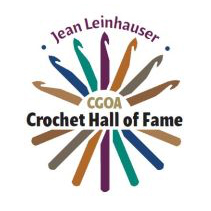Examples of celluloid crochet hooks (top to bottom) – Diadem Manufacturing Company imitating ivory, tortoise shell imitation, imitation amber hook came in a variety of transparent colors from “apple juice” as shown to “cranberry”, Sunlight Yarn Company with hollow ivory colored handle and solid black plugs at both ends.
The first plastic used for consumer goods, specifically celluloid, was used for crochet hooks as early as 1912. The British patent for celluloid was issued to Parkes in England in 1856. The US patent was issued to Hyatt in 1878 and expired in 1892.
Celluloid is a naturally clear, hard, shiny, durable substance. It can assume any desired color or opacity. Early on, it almost always imitated natural materials: ivory, tortoise shell, amber, horn, coral, agate, malachite, or wood. For crochet hooks, celluloid joined the market imitating the first three of these items. Its main advantage was to manufacturers because celluloid was more consistent in quality and all of the waste could be reused. Its main disadvantage is that it is flammable. Celluloid exposed to high heat or open flame bursts into flame. In the factories, this resulted in frequent fires. At home, women with celluloid buttons on their dresses sometimes had the buttons burst into flame if they got too close to the stove.
Celluloid, ivory, tortoise shell, horn, and bone, all of which were used for larger size crochet hooks, all had some supply problems between 1900 and WWI. The quality of Celluloid varied, sometimes turning color, bubbling, warping, etc. Camphor, derived from the camphor tree and used in the Celluloid manufacturing process, became hard to obtain due to deforestation of the camphor trees in Asia. Eventually, artificial camphor was invented. Ivory was available but the price and quality both fluctuated widely and it was always more expensive than Celluloid. Tortoise shell required a long process to prepare it for use, so it too was more expensive than Celluloid. Horn became scarce by 1900 as ranchers adopted the practice of dehorning cattle before shipping them to market. Cow shin bone of sufficient length became hard to get in the late 1920s as US ranchers began to ship cattle to market at a younger age.
Eventually, celluloid became more consistent in quality, easier to obtain, faster to manufacture, and, therefore, cheaper than natural materials used for crochet hooks although it never completely replaced any of them. That would be done by later proprietary plastics.
WARNING—because Celluloid is constantly degasses and both the gas and the Celluloid itself are flammable, store Celluloid crochet hooks in a container that allows air to circulate and keep Celluloid away from open flames.

